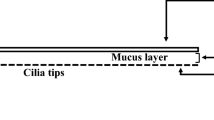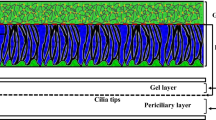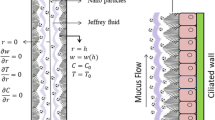Abstract
Mucous flow in a tracheal lumen is generated by the beat motion of ciliated cells to provide a clearance function by discharging harmful dust particles and viruses. Due to its physiological importance, the cilia-generated flow and the rheological properties of mucus have been investigated intensively. The effects of viscosity on the cilia-generated flow, however, have not been fully clarified. In this study, we measured bulk background velocity of ciliary flow using a micro particle tracking velocimetry method under various viscosity conditions in mice. The results showed that the flow velocity decreased as the increase with viscosity of ambient fluid. Moreover, no previous study has clarified the pump power generated by cilia, which provides important information with regard to understanding the molecular motor properties of cilia. Measurements of both the ciliary flow and the ciliary motion were conducted to determine the cilia pump power. Our results indicated that the cilia pump during the effective stroke did not drive the ciliary flow efficiently under high viscosity conditions; these findings are necessary to resolve the clearance function.









Similar content being viewed by others
References
Andrade, Y. N., et al. Trpv4 channel is involved in the coupling of fluid viscosity changes to epithelial ciliary activity. J. Cell. Biol. 168(6):869–874, 2005. doi:10.1083/jcb.200409070.
Chen, X., and H. C. Berg. Torque-speed relationship of the flagellar rotary motor of Escherichia coli. Biophys. J. 78(2):1036–1041, 2000. doi:10.1016/s0006-3495(00)76662-8.
Darnton, N. C., et al. On torque and tumbling in swimming Escherichia coli. J. Bacteriol. 189(5):1756–1764, 2007. doi:10.1128/jb.01501-06.
Francis, R. J., et al. Initiation and maturation of cilia-generated flow in newborn and postnatal mouse airway. Am. J. Physiol. Lung Cell. Mol. Physiol. 296(6):L1067–L1075, 2009. doi:10.1152/ajplung.00001.2009.
Gheber, L., A. Korngreen, and Z. Priel. Effect of viscosity on metachrony in mucus propelling cilia. Cell. Motil. Cytoskeleton. 39(1):9–20, 1998. doi:10.1002/(sici)1097-0169(1998)39:1<9::aid-cm2>3.0.co;2-3.
Herráez-Domínguez, J. V., et al. Rheological characterization of two viscosity grades of methylcellulose: an approach to the modeling of the thixotropic behaviour. Colloid Polym. Sci. 284(1):86–91, 2005. doi:10.1007/s00396-005-1332-3.
Huang, B. K., and M. A. Choma. Microscale imaging of cilia-driven fluid flow. Cell. Mol. Life Sci. 72(6):1095–1113, 2015. doi:10.1007/s00018-014-1784-z.
Hussong, J., et al. Cilia-driven particle and fluid transport over mucus-free mice tracheae. J. Biomech. 46(3):593–598, 2013. doi:10.1016/j.jbiomech.2012.08.020.
Inoue, Y., et al. Torque-speed relationships of Na+-driven chimeric flagellar motors in Escherichia coli. J. Mol. Biol. 376(5):1251–1259, 2008. doi:10.1016/j.jmb.2007.12.023.
Johnson, N. T., et al. Autoregulation of beat frequency in respiratory ciliated cells. Demonstration by viscous loading. Am. Rev. Respir. Dis. 144(5):1091–1094, 1991. doi:10.1164/ajrccm/144.5.1091.
Kiyota, K., et al. Fluctuation of cilia-generated flow on the surface of the tracheal lumen. Am. J. Physiol. Lung Cell. Mol. Physiol. 306(2):L144–L151, 2014. doi:10.1152/ajplung.00117.2013.
Kunimoto, K., et al. Coordinated ciliary beating requires Odf2-mediated polarization of basal bodies via basal feet. Cell 148(1–2):189–200, 2012. doi:10.1016/j.cell.2011.10.052.
Lai, S. K., et al. Micro- and macrorheology of mucus. Adv. Drug. Deliv. Rev. 61(2):86–100, 2009. doi:10.1016/j.addr.2008.09.012.
Lee, W. L., et al. Muco-ciliary transport: effect of mucus viscosity, cilia beat frequency and cilia density. Comput. Fluids 49(1):214–221, 2011. doi:10.1016/j.compfluid.2011.05.016.
Matsui, H., et al. Coordinated clearance of periciliary liquid and mucus from airway surfaces. J. Clin. Invest. 102(6):1125–1131, 1998. doi:10.1172/jci2687.
O’Callaghan, C., K. Sikand, and M. A. Chilvers. Analysis of ependymal ciliary beat pattern and beat frequency using high speed imaging: comparison with the photomultiplier and photodiode methods. Cilia 1(1):8, 2012. doi:10.1186/2046-2530-1-8.
Ryser, M., et al. Functional imaging of mucociliary phenomena: high-speed digital reflection contrast microscopy. Eur. Biophys. J. 37(1):35–54, 2007. doi:10.1007/s00249-007-0153-3.
Saadatmand, M., et al. Fluid particle diffusion through high-hematocrit blood flow within a capillary tube. J. Biomech. 44(1):170–175, 2011. doi:10.1016/j.jbiomech.2010.09.004.
Sanderson, M. J., and M. A. Sleigh. Ciliary activity of cultured rabbit tracheal epithelium: beat pattern and metachrony. J. Cell Sci. 47:331–347, 1981.
Smith, D. J., E. A. Gaffney, and J. R. Blake. A model of tracer transport in airway surface liquid. Bull. Math. Biol. 69(3):817–836, 2007. doi:10.1007/s11538-006-9163-z.
Smith, D. J., E. A. Gaffney, and J. R. Blake. A viscoelastic traction layer model of muco-ciliary transport. Bull. Math. Biol. 69(1):289–327, 2007. doi:10.1007/s11538-005-9036-x.
Smith, D. J., E. A. Gaffney, and J. R. Blake. Discrete cilia modelling with singularity distributions: application to the embryonic node and the airway surface liquid. Bull. Math. Biol. 69(5):1477–1510, 2007. doi:10.1007/s11538-006-9172-y.
Sowa, Y., et al. Torque-speed relationship of the Na+-driven flagellar motor of vibrio alginolyticus. J. Mol. Biol. 327(5):1043–1051, 2003.
Ueno, H., et al. Mouse respiratory cilia with the asymmetric axonemal structure on sparsely distributed ciliary cells can generate overall directional flow. Nanomedicine 8(7):1081–1087, 2012. doi:10.1016/j.nano.2012.01.004.
Yi, W. J., et al. Correlation between ciliary beat frequency and metachronal wave disorder using image analysis method. Med. Biol. Eng. Comput. 41(4):481–485, 2003.
Acknowledgement
This research was supported by JSPS KAKENHI [Grant Numbers 25000008 and 26242039].
Conflict of interest
The authors certify that no conflict of interest is raised by this work.
Author information
Authors and Affiliations
Corresponding author
Additional information
Associate Editor Merryn Tawhai oversaw the review of this article.
Electronic supplementary material
Below is the link to the electronic supplementary material.
Supplementary material 2 (MP4 32655 kb)
Rights and permissions
About this article
Cite this article
Kikuchi, K., Haga, T., Numayama-Tsuruta, K. et al. Effect of Fluid Viscosity on the Cilia-Generated Flow on a Mouse Tracheal Lumen. Ann Biomed Eng 45, 1048–1057 (2017). https://doi.org/10.1007/s10439-016-1743-y
Received:
Accepted:
Published:
Issue Date:
DOI: https://doi.org/10.1007/s10439-016-1743-y




